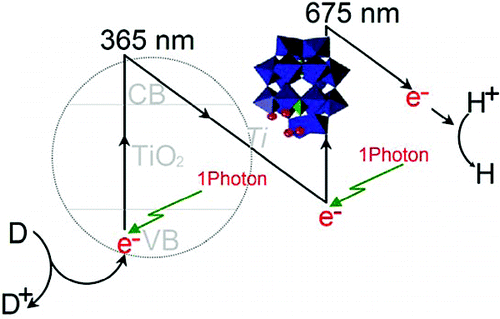To improve the stability of HPB sensitized TiO2 through combining TiO2 and P2W17 to build an artificial photosystem without electron mediators for stable photocatalysis (Scheme 1), researchers from Lanzhou Institute of Chemical Physics and University of Alberta have developed a photocatalytic system mimicking the Z-scheme without electron mediators, in which photosystems (PS) I and PS II were separated in space but operated simultaneously, resulting in two photochemical reactions that operate in parallel.
This approach of utilizing two light beams including UV and visible light provides a new route for efficient conversion of solar energy. This nontoxic system has demonstrated higher stability in a wide pH range from 1 to 13, higher effectiveness in separating electron-hole pairs, and greater photoactivity than a single component system. Such improvement is attributed to the directional electron transfer actuated by the photoexcitation of TiO2 and heteropoly blue, respectively.
Increasing of electron-hole separation is crucial to the improvement in the activity of photocatalyst. Photosynthesis involving the Z-scheme mechanism provides a unique process to utilize the solar energy by various biosystems and natural lives through effective electron-hole pair separation. This is an inspiring approach to the solar energy conversion for, e.g., photocatalysis of H2 evolution. Although some progress has been made in this technological area, a nontoxic photocatalytic system with a wide pH range by directional electron transfer with simple coupling of components has still not been achieved.
The work has received support from National Program on Key Basic Research Project of China, National High-tech R&D Program of China and Solar Energy Project of Chinese Academy of Sciences. The findings have been published in J. Phys. Chem. C (J. Phys. Chem. C 2011, 115, 8586–8593).
J. Phys. Chem. CPaper

Photoinduced Electron Transfer in the TiO2-HPB System, in Which the Separation of Hole-Electron Pairs of TiO2 by 365 nm UV Light and Excitement of Electrons in HPB by 675 nm Light Are Similar to Those in the PS I and PS II during Photosynthesis
